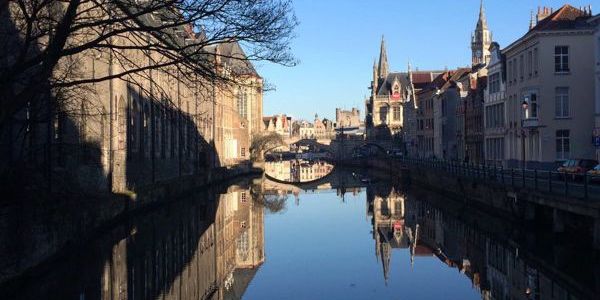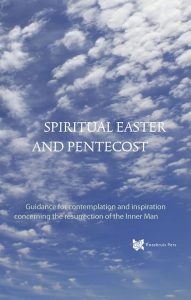WEDNESDAY BEFORE EASTER
THE CLEANSING OF THE INNER TEMPLE
Destroy this temple and in three days I will raise it up.
The gnostic path is the road that leads to the resurrection of the inner man and leads to liberation from the wheel of birth and death. If the desire to go that path awakens in a person, then that need is a sign that the divine spark has flared up, that the Christ principle in the heart has awakened.
In the beginning that desire is still fragile and unstable. If the inner flame in the heart of the microcosm lacks attention, it will soon be extinguished due to the many impulses coming to us from daily life, impulses that attract our attention and distract us from the newly ignited divine spark within us. The gnostic liberating path can only be walked on the basis of an awakened spirit-spark. For this reason the soul of the pupil is advised to ‘enter into the centre and to ascend into the spirit ‘.
Spiritual traditions such as mystery schools are there to enable a human being to keep the desire for wholeness alive and to provide him with the spiritual nourishment necessary for spiritual awakening and renewal. Through a continued focus on the high goal, reinforced through meetings, spiritual traditions constitute a focal point of spiritual energies. These forces flow from that focal point into a force field in which the members of the spiritual tradition can breathe and thus give the inner being the opportunity to grow.
Temples play an essential role in many spiritual schools. If things are right, a temple is more than a building where religious gatherings are held. A true temple is a focal point of spiritual force, an invisible reservoir of spiritual energies that are constantly replenished and will increase in force by means of the focus being sustained.
A temple building can only function as a true temple, so as a spiritual focus, if it is kept clean in all respects. Physical dirt, noise, degrading or wounding thoughts and earthly orientations disturb the highly sensitive temple field and weaken it, or may even lead to complete withdrawal of the spiritual force.
In this light it is understandable what Jesus means when he rebukes the cattle dealers and money changers that he finds in the temple in Jerusalem. Much less understandable is how Jesus, who is considered the incarnation of universal love, rages here. In chapter 71 of The Gospel of the Holy Twelve, we read:
When the Jews’ Passover was at hand, Jesus went up again from Bethany into Jerusalem. He found sitting in the temple those who sold oxen and sheep and doves, and money changers.
When he had made a whip of seven cords, he drove them all out of the temple and let loose the sheep and the oxen and the doves, and poured out the money of the changers and overthrew the tables.
He said to them, “Take these things; do not make my Father’s House a house of merchandise. Is it not written, ‘My House is a House of prayer, for all nations?’ But you have made it a den of thieves, and filled it with all manner of disgraceful things.”
He would not allow any man to carry a vessel of blood through the temple or any animals to there be slain. The disciples remembered that it was written, “Zeal for your house has eaten me up.”
The Gospel of the Holy Twelve 71: 1-4
The behaviour that Jesus shows here is so at odds with everything else that has been written about him, you’d almost think this narrative is not authentic. Yet it appears in all four gospels in the Bible. In the past, the literal interpretation of the narrative of the temple cleansing was often used to excuse violent and aggressive behaviour.
But when we apply the inner key, then a very different picture is shown. Strictly speaking, the narrative about the temple cleansing is not an historical account. Considered purely spiritually, the narrative of the temple cleansing informs us about the inner path by means of images. The correct key is to be found in the narrative itself. In chapter 71 of The Gospel of the Holy Twelve, we read further:
Then answered the Jews, and said to him, “What sign do you show us, since you are doing these things?” Jesus answered and said to them, “Again I say to you, destroy this temple and in three days I will raise it up.”
Then the Jews said, “This temple took forty-six years to build and you will raise it up in three days?” But he spoke of the temple of his Body.
Therefore when he had risen from the dead, his disciples remembered that he had said this to them; and they believed the scripture and the word which Jesus had said.
The Gospel of the Holy Twelve 71: 5-7
The word ‘temple’ is used here in a very special way. It not only refers to a building for religious ceremonies but also to the temple of the body, by which is meant both the physical body and the entire human personality. A personality is an individual who is able to think, feel and act in this world by means of a physical body.
Adam, the original, incorporeal divine man was a temple of the spirit. Through what is known as ‘the fall’ the spiritual forces retreated and the human temple was desecrated, becoming powerless. Countless new personalities have been living for centuries in the violated microcosmic temple, all of them leaving their mark.
This process continues until a personality comes along who has reached the state of experience-fullness and is powerful enough to restore the violated microcosmic temple to its true function. This restoration must be based on an awakened spirit-spark, for the spark of the soul is the spiritual focal point for the spirit; the microcosm is the radiating force field.
This process of regeneration can therefore take place only when the spirit-spark is ignited and the personality is willing to become a temple of the Spirit in order to become spiritualised right up to and including the physical body. This process is called transfiguration: construction of the inner temple, in which the resurrection body is established.
A person following his inner calling will therefore be cleansed of anything that hinders the inflow of spiritual force. Step by step forces directed on earthly life are broken off to make room for new spiritual strength.
A floor cannot wipe itself however, and therefore all these cleanings are performed by the spiritual light that increasingly can descend in the temple of the person concerned. If the Christ principle within has awakened and the inner Christ has reached a certain strength, then the seven rays are active within a person. These rays of the Seven Spirit, symbolised by the whip with seven ropes, will break off those things in man that do not relate harmoniously to the divine life.
The increasingly stronger light forces cause quite a stir in the life of a person seeking gnostic fulfilment. Values that were formerly thought to be unshakable become worthless. Greed, symbolised by the merchants and money changers, is driven out of the inner temple.
The sheepish herd behaviour that thoughtlessly followed the way of the majority now makes way for self-authority. Only on this basis can a person give the right direction to his own life, using his internal compass. The sheep also symbolise the forces within man that are themselves supporting to the spiritual path but, in ignorance, are still deployed on the earthly plane of life.
It is the strength of the ox to continue at a steady pace on this path once it has been chosen, but even the ox is still in the hands of the merchants of this earth who represent our possessiveness. The spiritual light liberates this strength and directs it toward the higher life so that one can progress strongly on the new path.
Every person knows the desire for romantic love, the Venus-love. This desire is symbolised by the pigeons. But the human heart is capable of much higher love. The heart is a temple in itself, the residence of the universal love that includes everything and everyone. When the pigeons are released from the hands of the merchants, they elevate their hearts to the universal, all-encompassing love. That universal Love is a higher octave of Venus-love and is symbolised by Uranus.
Every pupil of the soul who perseveres on the gnostic path experiences chaos during a certain period of his life, when it seems that almost everything he undertakes falls apart in his hands. Fortunately this situation is temporary and he learns to recognise that the breaking up of obstructions is necessary in order to build the new inner temple. The caterpillar must die before it can become a butterfly. The true pupil of the soul allows this to happen in tranquillity and confidence.
Jesus announced that he would build a new temple in three days; the Gospels tell us that he rose from the dead after three days. Here again the inner key applies because the three days mentioned indicate that it concerns a threefold process. This trinity is also reflected in a well-known motto of the seventeenth-century Rosicrucians which reads:
We are born of God,
in Jesus we die,
through the Holy Spirit we are reborn.

